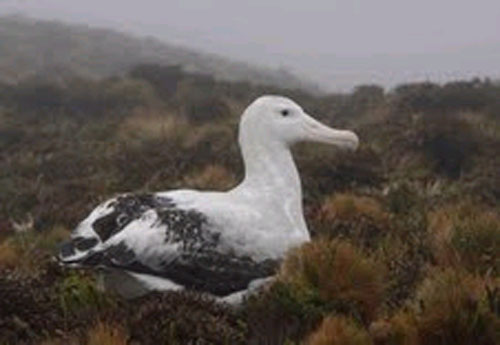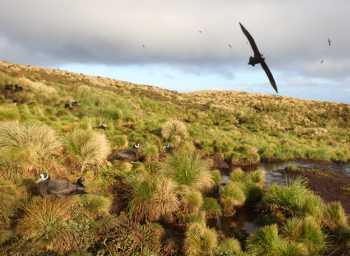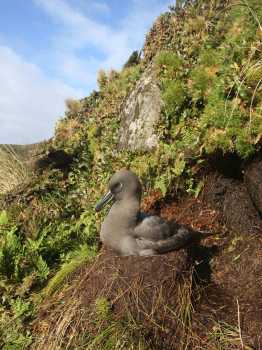
Inaccessible Island from the east, with Harold's Plain in the foreground, the lowest area on the island's plateau. The island is named more for its sheer cliffs around much of the coast rather than for the difficulty of landing. Inaccessible and its surrounding waters are a nature reserve, a Ramsar Wetland of International Importance and part of a World Heritage Site along with Gough Island.

Only a few Critically Endangered Tristan Albatrosses Diomedea dabbenena still breed on Inaccessible Island, where they are confined to the highest ridges. This unmated bird held territory on Long Ridge in 2009, but most nests are located on Gony Ridge, farther west.

Spectacled Petrels Procellaria conspicillata are confined to the island's plateau, where most breed in dense colonies that cut into the Bog Fern Blechnum palmiforme slopes, creating terraces of the sedge, Big Bog Grass Scirpus sulcatus.

Atlantic Yellow-nosed Albatrosses Thalassarche chlororhynchos nest at relatively low densities across the island's plateau and on some of the upper slopes. Molly Bog, shown here, is one of the few places where they breed at moderate densities. Note the main island of Tristan in the background, beyond Round Hill.

Small numbers of Sooty Albatrosses Phoebetria fusca breed on low ridges in the plateau interior, but most breed along the sheer coastal cliffs, where their numbers are hard to count.
Selected references:
RSPB & Tristan da Cunha Government 2010. Gough and Inaccessible Islands World Heritage Site Management Plan April 2010 – March 2015. [Sandy: Royal Society for the Protection of Birds & Edinburgh, Tristan da Cunha: Government of Tristan da Cunha]. 32 pp.
Ryan, P.G. 2005. Inaccessible Island Seabird Monitoring Manual. RSPB Research Report No.16. Sandy: Royal Society for the Protection of Birds. 32 pp.
Ryan, P.G. (Ed.) 2007. Field Guide to the Animals and Plants of Tristan da Cunha and Gough Island. Newbury: Pisces Publications. 162 pp.
Ryan, P.G. 2008. Important Bird Areas: Tristan da Cunha and Gough Island. British Birds 101: 586-606.
Ryan, P.G. & Glass, J.P. 2001. Inaccessible Island Nature Reserve Management Plan. Edinburgh, Tristan da Cunha: Government of Tristan da Cunha. 65 pp.
Ryan, P.G. & Ronconi, R.A. 2011. Continued increase in numbers of Spectacled Petrels Procellaria conspicillata. Antarctic Science 23: 332-336.
Peter Ryan, FitzPatrick Institute, University of Cape Town, South Africa, 18 February 2013

 English
English  Français
Français  Español
Español